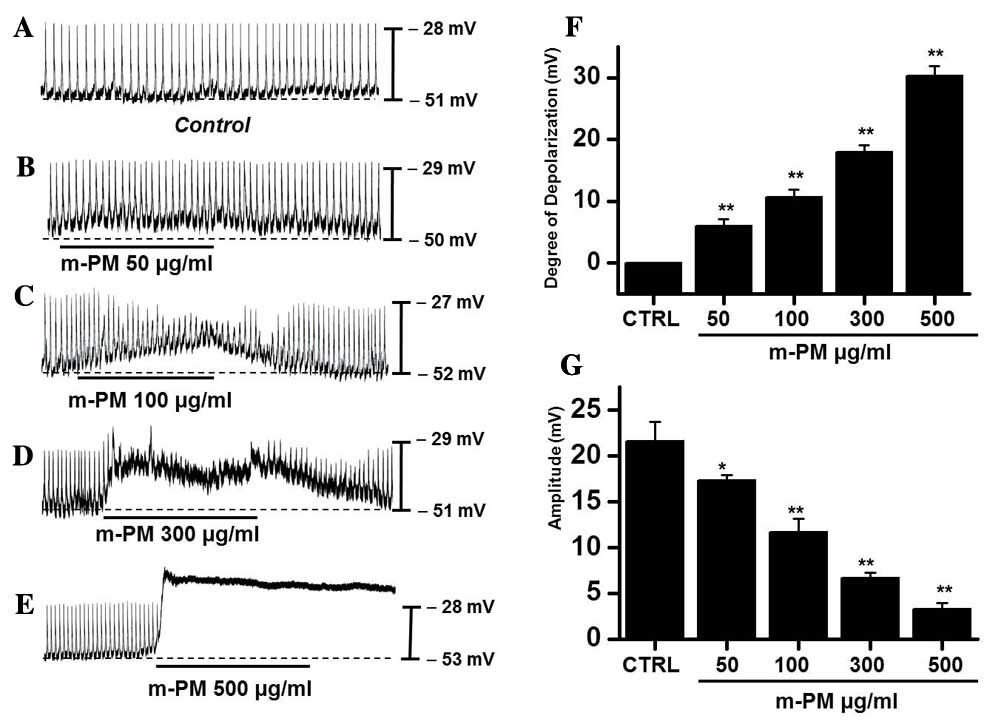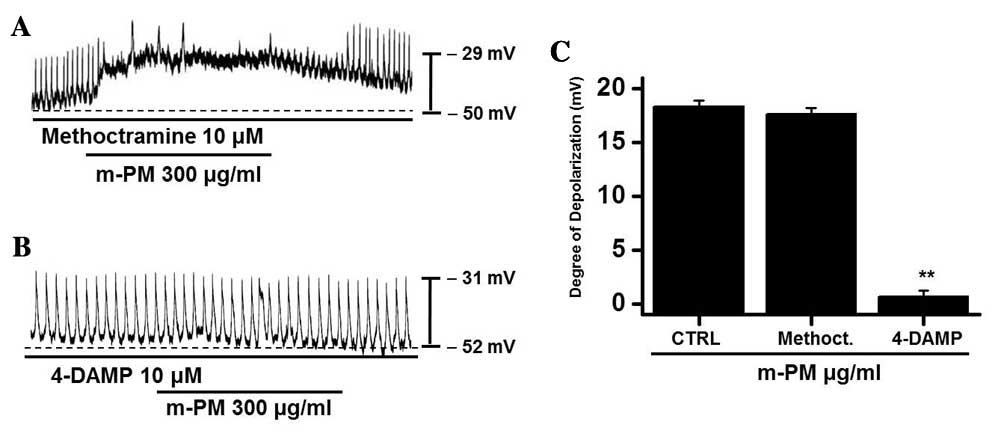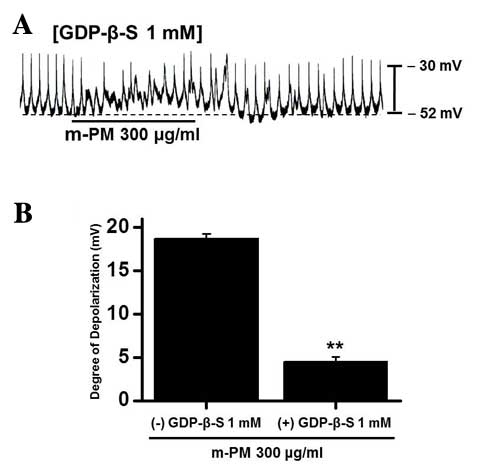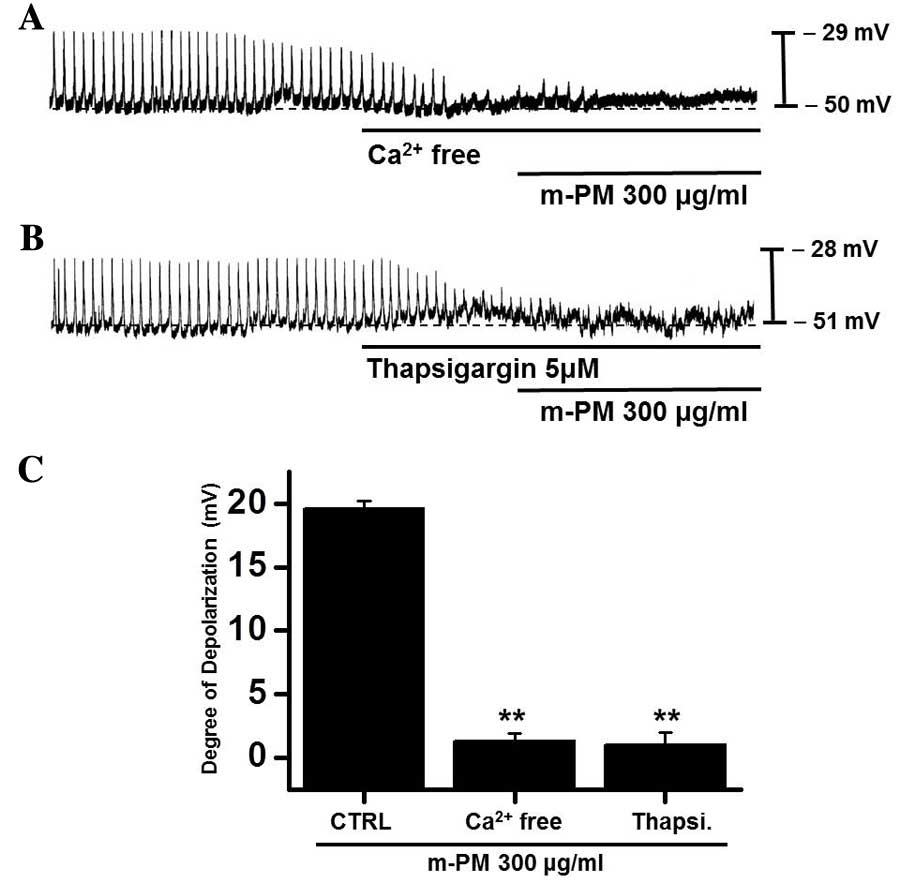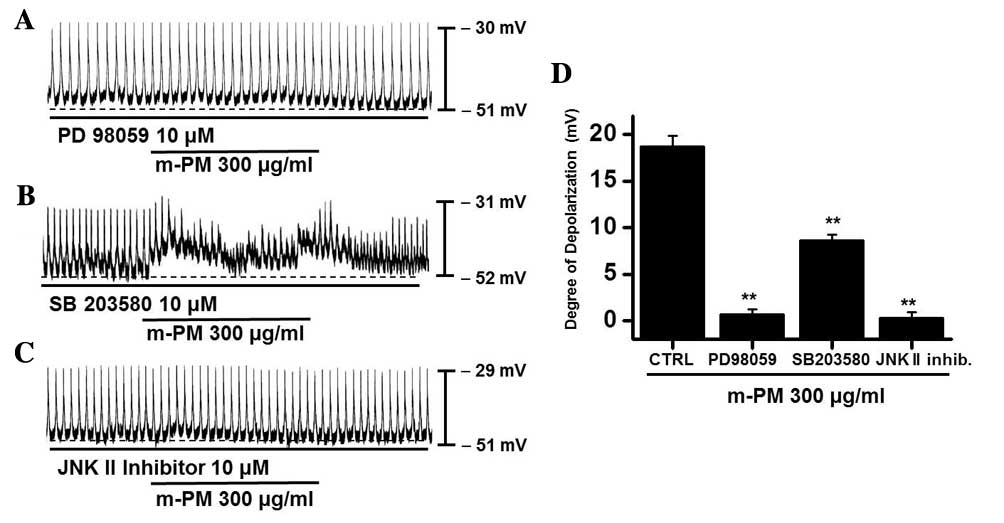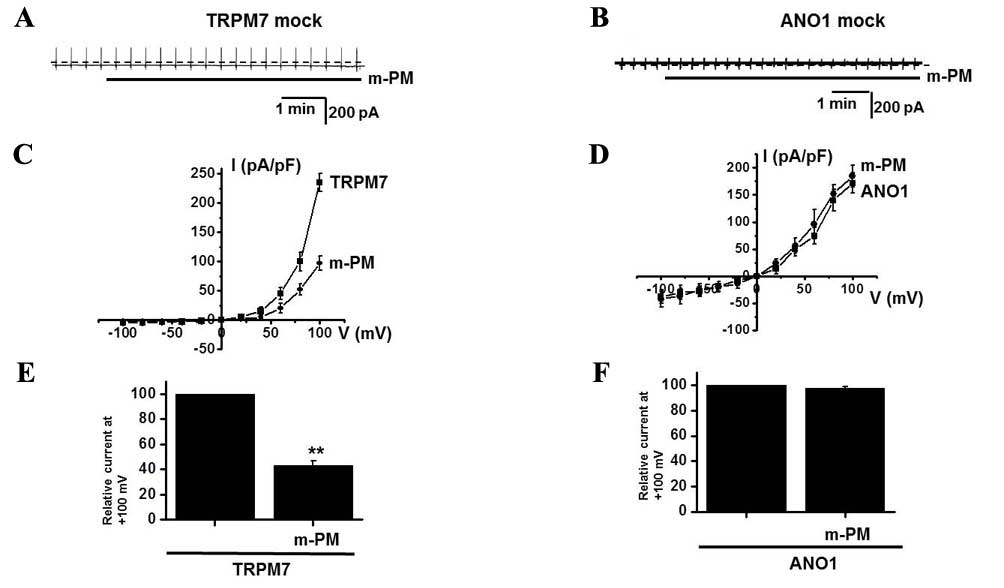Effects of Prunus mume Siebold & Zucc. in the pacemaking activity of interstitial cells of Cajal in murine small intestine
- Authors:
- Published online on: December 7, 2016 https://doi.org/10.3892/etm.2016.3963
- Pages: 327-334
Abstract
Introduction
The fruit of the plum tree Prunus mume Siebold & Zucc. (PM) is used across East Asia, particularly in Korea and Japan (1), as a traditional herbal medicine for the relief of digestive problems, fatigue and fever. PM contains a number of phenolic compounds, including phenolic acids and flavonoids (1,2), which have antioxidant and free radical scavenging activities in vivo (3–6). Furthermore, PM extracts exhibit many pharmacological activities, including antimicrobial (7–10), immune enhancing (11), anti-cancer (1,12,13), and anti-fatigue (14) effects, and have been demonstrated to enhance osteoclast differentiation (15) and improve blood flow (16). Additionally, previous studies have reported that using PM extracts with probiotics inhibits the development of atopic dermatitis (17) and enhances immunity (18).
Interstitial cells of Cajal (ICCs) are the pacemakers of the gastro-intestinal tract and generate rhythmic responses in cell membrane electrical potentials (19,20), thus serving important roles in the regulation of GI motility (21). Additionally, endogenous agents are able to regulate GI motility function via ICCs (22–25). Furthermore, transient receptor potential melastatin (TRPM) 7 (26) or Cl− channels, such as anoctamin1 (ANO1) (27–29), are associated with pacemaker potentials in the GI tract. Therefore, TRPM7 and ANO1 may be therapeutic targets for the treatment of GI motility disorders.
It has been reported previously that PM is able to enhance the propulsive motion and motility of the small intestine (7) and promote the frequency of defecation and colon contraction in rats, which supports the potential role of PM as a therapeutic agent for the treatment of constipation (30). However, little is known about the effect of PM on ICC clusters in the GI tract. The aims of the present study were to evaluate the effects of the methanoic extract of PM (m-PM) on the electrical pacemaker potentials of cultured ICCs and characterize m-PM-mediated signaling pathways.
Materials and methods
Preparation of m-PM
PM fruits were harvested in the Wondong area, (Yangsan, Geongnam, Korea) in June 2012 and were authenticated by Professor Hyungwoo Kim (School of Korean Medicine, Pusan National University, Yangsan, Korea). A standard extraction process was performed to obtain m-PM, as previously described (24). Briefly, 50 g PM fruit was immersed in 0.5 l methanol, sonicated for 15 min and allowed to stand for 24 h. The extract obtained was filtered through No. 20 Whatman filter paper and lyophilized using a freeze dryer (Labconco Corp., Kansas City, MO, USA). A total of 2.42 g of lyophilized powder (m-PM) was subsequently obtained (yield, 4.84%). A 12.1 g sample of m-PM was deposited at the School of Korean Medicine, Pusan National University (voucher no. MH2012-008).
Ethics
Animal care and experiments were conducted in accordance with the guidelines issued by the ethics committee of Pusan National University (Busan, Korea; Approval no. PNU-2014-0725) and the National Institutes of Health Guide for the Care and Use of Laboratory Animals (31).
Preparation of cells and cell cultures
A total of 78 BALB/c mice (male:female, 41:37; age, 4–7 days; weight, 2.0–2.2 g; Samtako Bio Korea Co., Ltd., Osan, Korea) were anesthetized with 0.1% ether (Sigma-Aldrich; Merck Millipore, Darmstadt, Germany) and sacrificed using cervical dislocation. Mice were maintained under controlled conditions (temperature, 20±2°C; humidity, 50±5%; 12 h light/dark cycles) and were allowed free access to food and water. Small intestines were removed and opened along the mesenteric border, and luminal contents were removed via washing with Krebs-Ringer bicarbonate solution. Sharp dissection was performed to remove small intestine mucosae and small strips of intestine muscle were subsequently equilibrated in Ca2+-free physiological salt solution (in mmol/l: 125 NaCl, 5.36 KCl, 0.34 NaOH, 0.44 Na2HCO3, 10 glucose, 2.9 sucrose, and 11 HEPES buffer) for 20 min and dispersed using an enzyme solution containing 1.5 mg/ml collagenase (Worthington Biochemical Corp., Lakewood, NJ, USA), 2.5 mg/ml bovine serum albumin (Sigma-Aldrich; Merck Millipore), 2.5 mg/ml trypsin inhibitor (Sigma-Aldrich; Merck Millipore) and 0.5 mg/ml adenosine triphosphate (ATP) (Sigma-Aldrich; Merck Millipore). Cells were plated on glass coverslips coated with 0.01% poly-L-lysine solution (Sigma-Aldrich; Merck Millipore) and cultured in an atmosphere containing 95% O2 and 5% CO2 in smooth muscle basal medium (Clonetics Corp.; Lonza, Walkersville, MA, USA) supplemented with stem cell factor (5 ng/ml; Sigma-Aldrich; Merck Millipore) and 1% penicillin/streptomycin (Gibco; Thermo Fisher Scientific, Inc., Waltham, MA, USA) at 37°C.
Whole cell patch-clamp experiments
The Na+-Tyrode solution used in bath solution contained 135 mM NaCl, 5 mM KCl, 135 mM NaCl, 2 mM CaCl2, 10 mM glucose, 1.2 mM MgCl2 and 10 mM 4-(2-hydroxyethyl)-1-piperazineethanesulfonic acid (HEPES) buffer, adjusted to pH 7.4 with NaOH. A pipette solution was also used, which contained 140 mM KCl, 5 mM MgCl2, 2.7 mM K2ATP, 0.1 mM Na guanosine triphosphate (GTP), 2.5 mM creatine phosphate disodium, 5 mM HEPES buffer and 0.1 mM ethylene glycol bis (2-aminoethyl ether)-N, N,N',N'-tetraacetic acid (EGTA), adjusted to pH 7.2 with KOH. The whole-cell patch-clamp technique was performed to record the membrane electrical potentials in cultured ICCs and membrane potentials were amplified using an Axopatch 1-D (Molecular Devices, LLC, Sunnyvale, CA, USA). Command pulses were applied using a Samsung-compatible personal computer and pClamp software (ver. 9.0; Molecular Devices). Data were filtered at 1 kHz and displayed on a computer monitor. pClamp and Origin software (ver. 8.0; MicroCal, Northampton, MA, USA) were used for statistical analysis. All experiments were performed at 30°C.
TRPM7 overexpression
Human embryonic kidney (HEK)-293 cells (American Type Culture Collection, Manassas, VA, USA) were transfected with Flag-murine LTRPC7/pCDNA4-TO construct and subsequently cultured in Dulbecco's Modified Eagle medium (Thermo Fisher Scientific, Inc.) supplemented with 5 µg/ml blasticidin, 0.4 mg/ml zeocin and 10% fetal bovine serum (Thermo Fisher Scientific, Inc.). Adding 1 µg/ml tetracycline to the medium for 24 h induced TRPM7 overexpression. HEK293 cells overexpressing TRPM7 were bathed in a solution containing 145 mM NaCl, 2.8 mM KCl, 2 mM CaCl2, 10 mM glucose, 1.2 mM MgCl2 and 10 mM HEPES buffer, adjusted to pH 7.4 with NaOH. The pipette solution contained 145 mM Cs-glutamate, 8 mM NaCl, 10 mM Cs-2-bis (2-aminophenoxy)-ethane-N,N,N',N'-tetraacetic acid, and 10 mM HEPES-CsOH, adjusted to pH 7.3 with CsOH.
Ca2+ activated Cl− channel overexpression
HEK-293 cells were transfected with the pEGFP-N1-mANO1 construct for 24 h and these cells were cultured on glass coverslips in Dulbecco's Modified Eagle medium, which was supplemented with 10% fetal bovine serum. The bath solution contained 146 mM HCl, 10 mM HEPES, 10 mM glucose, 1 mM MgCl2, 1 mM CaCl2 and 150 mM N-methyl-D-glucamine (NMDG), adjusted to pH 7.4. The pipette solution contained 150 mM NMDG-Cl, 1 mM MgCl2, 3 mM MgATP, 10 mM EGTA, 5 mM CaCl2 and 5 mM HEPES buffer at pH 7.2 (titrated with NMDG). WEBMAX-C STANDARD software (C. Patton, Stanford University, www.stanford.edu/~cpatton/maxc.html) was used to fix the free calcium concentration at 200 nM.
Pharmacological agents
Pharmacological agents, including methoctramine, 4-diphenylacetoxy-N-methyl-piperidine methiodide (4-DAMP), guanosine 5′-O-(2-thiodiphosphate) (GDP-β-S), thapsigargin, PD98059, SB203580 and SP600125, were purchased from Sigma-Aldrich (Merck Millipore). They were dissolved in dimethyl sulfoxide (DMSO) or distilled water and stored at −20°C. The final concentration of DMSO in the bath solution was maintained at <0.1%.
Statistical analysis
Results are expressed as mean ± standard error of the means. Student's t-test for unpaired data was performed to compare control and experimental groups. Origin software (version 8.0; OriginLab, Northampton, MA, USA) was used to perform statistical analysis. P<0.05 was considered to indicate a statistically significant difference.
Results
Effect of m-PM on pacemaker electrical potentials in cultured ICCs
The effect of m-PM on pacemaker electrical potentials in cultured ICCs was investigated. Mean resting electrical potential of membranes was −51.7±2.4 mV and the electrical amplitude was 21.6±2.3 mV. Following m-PM administration (50–500 µg/ml), mean membrane electrical potentials were depolarized to 6.2±1.3 (50 µg/ml), 10.6±1.2 (100 µg/ml), 18.5±1.5 (300 µg/ml) and 30.3±1.6 mV (500 µg/ml; Fig. 1A-E), and corresponding amplitudes decreased to 17.3±0.6, 11.4±1.5, 6.7±0.8, and 3.3±0.5 mV, respectively (Fig. 1B-E). The effects of m-PM on pacemaker electrical potentials are presented in Fig. 1F and G (n=7). These results suggest that m-PM modulates the pacemaker potentials of ICCs.
m-PM receptors in cultured ICCs
To study the m-PM receptors on ICCs, muscarinic receptors were investigated as they mediate membrane electrical depolarization in the GI tract (32,33). Furthermore, it has been demonstrated that ICCs express M2 and M3 muscarinic receptors in the GI tract (34). Pretreatment with muscarinic receptor antagonists was performed to identify which muscarinic receptor was associated with the response. Membranes were pretreated with 10 µm methoctramine, which is a muscarinic M2 receptor antagonist, or 4-DAMP, which is a muscarinic M3 receptor antagonist, for 5 min prior to m-PM (300 µg/ml) administration. Neither antagonist had any effect on pacemaker potentials. Methoctramine did not inhibit the effect of m-PM (Fig. 2A), whereas 4-DAMP was able to inhibit m-PM-induced membrane depolarization (Fig. 2B). The mean membrane electrical depolarization by m-PM following pretreatment with methoctramine or 4-DAMP was 17.5±0.7 and 0.9±0.4 mV, respectively (n=5 in each; Fig. 2C). These results indicate that m-PM affects ICCs through M3 receptors, not M2 receptors.
Association between G proteins and m-PM-induced pacemaker electrical potentials in cultured ICCs
GDP-β-S, which permanently inactivates G-protein binding proteins (35,36), was administered to determine whether G-proteins are associated with the effects of m-PM on cultured ICCs. m-PM (300 µg/ml) induced ICC membrane depolarization (Fig. 1D); however, when GDP-β-S (1 mM) was present in the pipette solution, m-PM-induced depolarization was markedly reduced (n=5; Fig. 3). These results suggest that G-proteins have a role in the m-PM-induced pacemaker depolarization of ICCs.
Effects of external Ca2+-free solution and Ca2+-ATPase inhibitor of endoplasmic reticulum on m-PM-induced pacemaker electrical potentials of cultured ICC
An influx of external Ca2+ is required for GI contractions and pacemaker electrical depolarizations in ICCs (37). Furthermore, pacemaker electrical depolarizations are regulated by intracellular Ca2+ modulations (37). To investigate the roles of external and internal Ca2+ on m-PM-induced pacemaker depolarizations, m-PM was applied in the absence of external Ca2+ and in the presence of thapsigargin (a Ca2+-ATPase inhibitor in endoplasmic reticulum). When exposed to the external Ca2+-free condition, pacemaker potentials were abolished and were unaffected by the administration of m-PM (Fig. 4A). Pretreatment with thapsigargin (5 µM) also suppressed pacemaker electrical potentials and in these conditions, m-PM had no effect on pacemaker electrical potentials (Fig. 4B). The effects of m-PM on pacemaker electrical potentials are presented in Fig. 4C (n=6). These results suggest external Ca2+ or internal Ca2+ regulations modulate m-PM-induced pacemaker electrical potentials in cultured ICCs.
Association of mitogen-activated protein kinase (MAPKs) with m-PM-induced pacemaker potentials of cultured ICCs
To evaluate the mechanisms involved in the interaction between m-PM and M3 receptors, the role of mitogen-activated protein kinases (MAPKs) was investigated. It has been demonstrated that muscarinic receptors are able to activate MAPKs in various cell types (38,39); therefore, the potential role of MAPKs in regulating the effects of m-PM was determined by administrating a p42/44 MAPK inhibitor (PD98059), a p38 MAPK inhibitor (SB203580) or a c-jun NH2-terminal kinase (JNK) II inhibitor (SP600125). PD98059 (10 µM), m-PM did not induce membrane electrical depolarization (Fig. 5A). m-PM-induced membrane electrical depolarization was partially blocked by the administration of SB203580 (Fig. 5B) and completely blocked by the administration of SP600125 (Fig. 5C). The effects of m-PM on pacemaker electrical potentials are presented in Fig. 5D (n=5). These results suggest that MAPKs modulate m-PM-induced pacemaker electrical potentials in cultured ICCs.
Association of TRPM7 and Ca2+-activated Cl− channels with m-PM-induced pacemaker potentials in cultured ICCs
In the murine small intestine, pacemaker potentials are predominantly induced by the activation of non-selective cation channels (25,26) or Cl−channels (27–29). To determine which channel is associated with the m-PM-induced depolarization of pacemaker potentials, the effects of m-PM on TRPM7 and Ca2+-activated Cl− channels were examined. Membranes were transfected with the FLAG-murine TRPM7/pCDNA4/TO construct using Lipofectamine 2000 (Thermo Fisher Scientific, Inc.) and ~90% of cells were transfected. In a previous study, TRPM7-transfected HEK293 cells induced by tetracycline produced a flag-reactive band with a relative molecular mass of 220 kilodaltons (21). Another study revealed that ANO1 channels were overexpressed in HEK293 cells transfected with an ANO1 construct (40) and whole cell currents were recorded using patch-clamp techniques. In the present study, TRPM7 and ANO1 currents were activated in mock transfected cells (Fig. 6A and B) and it was demonstrated that m-PM inhibited the activities of TRPM7 channels, but did not affect the Ca2+-activated Cl− ANO1 channels (n=4; Fig. 6C-F), thus indicating that the effects of m-PM are attributable to TRPM7 channels.
Discussion
In the present study, it was demonstrated that administration of m-PM induced depolarization of ICC pacemaker potentials through muscarinic M3 receptor signaling pathways in a G protein-MAPK dependent manner. Furthermore, m-PM was able to inhibit TRPM7 currents, indicating that TRPM7 is associated with the m-PM-induced membrane depolarization of ICCs.
In intestinal motility, PM has been reported to enhance propulsive motion and small intestine motility, as determined by the coated charcoal method (7). Additionally, it has been demonstrated that PM has laxative effects in constipation rat models, as it accelerated the spontaneous contraction of isolated colon (30). Furthermore, citric and malic acid, the major organic acids in plums, stimulate spontaneous contractions in the colon (30). These findings support the commonly held belief that plums help to prevent constipation and that ICCs function as pacemakers in the small intestine thus modulating GI motility. In the present study, it was identified that m-PM depolarizes ICC pacemaker activity.
The authors of the present study have previously investigated the effects of traditional medicines on pacemaker electrical potentials in ICCs. It has been determined that Poncirus fructus (PF) is able to modulate pacemaker electrical potentials via the 5-hydroxytryptamine (5-HT)3 and 5-HT4 receptor pathways in a MAPK-dependent manner (24) and gintonin-mediated membrane depolarization and Ca2+-activated Cl− channel activation have been observed in cultured murine ICCs via a lysophosphatidic acid 1/3 receptor signaling pathway (41). Additionally, it was determined that San-Huang-Xie-Xin-tang (SHXXT) is able to modulate pacemaker electrical potentials (42). The results of in vivo experiments suggested that SHXXT-regulated GI motility was due to the activities of Coptidis rhizome and Rhei rhizome (42). Furthermore, Schisandra chinensis (Turcz.) Baill. extract (SC extract) was determined to modulate ICC pacemaker potentials via external and internal Ca2+ regulation, and via G protein and the phospholipase C (PLC) pathway, in a dose-dependent manner, and increased intestinal transit rates in mouse models of normal and abnormal GI motility (43). These studies indicate that traditional medicines, such as PF, ginseng, SHXXT and SC may potentially be used as gastroprokinetic agents. The results of the present study demonstrated that m-PM exhibited the potential of a prokinetic agent for GI motility dysfunctions.
The MAPK family of protein kinases serve critical roles in signal transduction (44,45) and the regulation of various cellular responses, including cell cycle progression, differentiation, inflammation, protein synthesis and proliferation (46). There are five subtypes of acetylcholine muscarinic receptors (M1-M5), of which three (M1, M3, and M5) are coupled with PLC through a Gq protein, whereas the other subtypes (M2 and M4) are able to inhibit adenylate cyclase via Go or Gi proteins (47). In various cellular systems, muscarinic receptor stimulation has been reported to activate MAPK (48,49). In the present study, the effects of m-PM on ICCs in the murine small intestine were investigated. m-PM modulated pacemaker activities in ICCs through muscarinic M3 receptor activation via G protein, PLC and MAPK-dependent mechanisms. Therefore, ICCs are targets for m-PM and this interaction may improve intestinal motility.
In conclusion, Prunus mume Siebold & Zucc. was able to depolarize ICC pacemaker potentials in a G protein and MAPK-dependent manner by stimulating M3 receptors. These findings suggest that Prunus mume Siebold & Zucc. may be developed as a potential gastroprokinetic agent for the treatment of GI motility disorders.
Acknowledgements
The present study was supported by the Research Institute for Convergence of Biomedical Science and Technology (grant no. 30-2014-011), Pusan National University Yangsan Hospital.
References
|
Jeong JT, Moon JH, Park KH and Shin CS: Isolation and characterization of a new compound from Prunus mume fruit that inhibits cancer cells. J Agric Food Chem. 54:2123–2128. 2006. View Article : Google Scholar : PubMed/NCBI | |
|
Kita M, Kato M, Ban Y, Honda C, Yaegaki H, Ikoma Y and Moriguchi T: Carotenoid accumulation in Japanese apricot (Prunus mume Siebold & Zucc.): Molecular analysis of carotenogenic gene expression and ethylene regulation. J Agric Food Chem. 55:3414–3420. 2007. View Article : Google Scholar : PubMed/NCBI | |
|
Kim BJ, Kim JH, Kim HP and Heo MY: Biological screening of 100 plant extracts for cosmetic use (II): Anti-oxidative activity and free radical scavenging activity. Int J Cosmet Sci. 19:299–307. 1997. View Article : Google Scholar : PubMed/NCBI | |
|
Tsai CH, Chang RC, Chiou JF and Liu TZ: Improved superoxide-generating system suitable for the assessment of the superoxide-scavenging ability of aqueous extracts of food constituents using ultraweak chemiluminescence. J Agric Food Chem. 51:58–62. 2003. View Article : Google Scholar : PubMed/NCBI | |
|
Matsuda H, Morikawa T, Ishiwada T, Managi H, Kagawa M, Higashi Y and Yoshikawa M: Medicinal flowers. VIII. Radical scavenging constituents from the flowers of Prunus mume: Structure of prunose III. Chem Pharm Bull (Tokyo). 51:440–443. 2003. View Article : Google Scholar : PubMed/NCBI | |
|
Kim TK, Cha MR, Kim SJ, Kim SY, Jeon KI, Park HR, Park EJ and Lee SC: Antioxidative activity of methanol extract from Prunus mume byproduct. Cancer Prev Res. 10:251–256. 2005. | |
|
Wang L, Zhang HY and Wang L: Comparison of pharmacological effects of Fructus Mume and its processed products. Zhong Yao Cai. 33:353–356. 2010.(In Chinese). PubMed/NCBI | |
|
Chen Y, Wong RW, Seneviratne CJ, Hägg U, McGrath C, Samaranayake LP and Kao R: The antimicrobial efficacy of Fructus mume extract on orthodontic bracket: A monospecies-biofilm model study in vitro. Arch Oral Biol. 56:16–21. 2011. View Article : Google Scholar : PubMed/NCBI | |
|
Seneviratne CJ, Wong RW, Hägg U, Chen Y, Herath TD, Samaranayake PL and Kao R: Prunus mume extract exhibits antimicrobial activity against pathogenic oral bacteria. Int J Paediatr Dent. 21:299–305. 2011. View Article : Google Scholar : PubMed/NCBI | |
|
Enomoto S, Yanaoka K, Utsunomiya H, Niwa T, Inada K, Deguchi H, Ueda K, Mukoubayashi C, Inoue I, Maekita T, et al: Inhibitory effects of Japanese apricot (Prunus mume Siebold et Zucc.; Ume) on Helicobacter pylori-related chronic gastritis. Eur J Clin Nutr. 64:714–719. 2010. View Article : Google Scholar : PubMed/NCBI | |
|
Kawahara K, Hashiguchi T, Masuda K, Saniabadi AR, Kikuchi K, Tancharoen S, Ito T, Miura N, Morimoto Y, Biswas KK, et al: Mechanism of HMGB1 release inhibition from RAW264.7 cells by oleanolic acid in Prunus mume Sieb. et Zucc. Int J Mol Med. 23:615–620. 2009.PubMed/NCBI | |
|
Mori S, Sawada T, Okada T, Ohsawa T, Adachi M and Keiichi K: New anti-proliferative agent, MK615, from Japanese apricot ‘Prunus mume’ induces striking autophagy in colon cancer cells in vitro. World J Gastroenterol. 13:6512–6517. 2007. View Article : Google Scholar : PubMed/NCBI | |
|
Kai H, Akamatsu E, Torii E, Kodama H, Yukizaki C, Sakakibara Y, Suiko M, Morishita K, Kataoka H and Matsuno K: Inhibition of proliferation by agricultural plant extracts in seven human adult T-cell leukaemia (ATL)-related cell lines. J Nat Med. 65:651–655. 2011. View Article : Google Scholar : PubMed/NCBI | |
|
Kim S, Park SH, Lee HN and Park T: Prunus mume extract ameliorates exercise-induced fatigue in trained rats. J Med Food. 11:460–468. 2008. View Article : Google Scholar : PubMed/NCBI | |
|
Youn YN, Lim E, Lee N, Kim YS, Koo MS and Choi SY: Screening of Korean medicinal plants for possible osteoclastogenesis effects in vitro. Genes Nutr. 2:375–380. 2008. View Article : Google Scholar : PubMed/NCBI | |
|
Chuda Y, Ono H, Ohnishi-Kameyama M, Matsumoto K, Nagata T and Kikuchi Y: Mumefural, citric acid derivative improving blood fluidity from fruit-juice concentrate of Japanese apricot (Prunus mume Sieb. et Zucc). J Agric Food Chem. 47:828–831. 1999. View Article : Google Scholar : PubMed/NCBI | |
|
Jung BG, Cho SJ, Koh HB, Han DU and Lee BJ: Fermented Maesil (Prunus mume) with probiotics inhibits development of atopic dermatitis-like skin lesions in NC/Nga mice. Vet Dermatol. 21:184–191. 2010. View Article : Google Scholar : PubMed/NCBI | |
|
Jung BG, Ko JH, Cho SJ, Koh HB, Yoon SR, Han DU and Lee BJ: Immune-enhancing effect of fermented Maesil (Prunus mume Siebold & Zucc.) with probiotics against Bordetella bronchi septica in mice. J Vet Med Sci. 72:1195–1202. 2010. View Article : Google Scholar : PubMed/NCBI | |
|
Huizinga JD, Thuneberg L, Kluppel M, Malysz J, Mikkelsen HB and Bernstein A: W/kit gene required for interstitial cells of Cajal and for intestinal pacemaker activity. Nature. 373:347–349. 1995. View Article : Google Scholar : PubMed/NCBI | |
|
Sanders KM: A case for interstitial cells of Cajal as pacemakers and mediators of neurotransmission in the gastrointestinal tract. Gastroenterology. 111:492–515. 1996. View Article : Google Scholar : PubMed/NCBI | |
|
Kim BJ, Lim HH, Yang DK, Jun JY, Chang IY, Park CS, So I, Stanfield PR and Kim KW: Melastatin-type transient receptor potential channel 7 is required for intestinal pacemaking activity. Gastroenterology. 129:1504–1517. 2005. View Article : Google Scholar : PubMed/NCBI | |
|
Lee JH, Kim SY, Kwon YK, Kim BJ and So I: Characteristics of the cholecystokinin-induced depolarization of pacemaking activity in cultured interstitial cells of Cajal from murine small intestine. Cell Physiol Biochem. 31:542–554. 2013. View Article : Google Scholar : PubMed/NCBI | |
|
Kim BJ, Kim SY, Lee S, Jeon JH, Matsui H, Kwon YK, Kim SJ and So I: The role of transient receptor potential channel blockers in human gastric cancer cell viability. Can J Physiol Pharmacol. 90:175–186. 2012. View Article : Google Scholar : PubMed/NCBI | |
|
Kim BJ, Kim HW, Lee GS, Choi S, Jun JY, So I and Kim SJ: Poncirus trifoliate fruit modulates pacemaker activity in interstitial cells of Cajal from the murine small intestine. J Ethnopharmacol. 149:668–675. 2013. View Article : Google Scholar : PubMed/NCBI | |
|
Koh SD, Jun JY, Kim TW and Sanders KM: A Ca2+-inhibited non-selective cation conductance contributes to pacemaker currents in mouse interstitial cell of Cajal. J Physiol. 540:803–814. 2002. View Article : Google Scholar : PubMed/NCBI | |
|
Kim BJ, So I and Kim KW: The relationship of TRP channels to the pacemaker activity of interstitial cells of Cajal in the gastrointestinal tract. J Smooth Muscle Res. 42:1–7. 2006. View Article : Google Scholar : PubMed/NCBI | |
|
Huizinga JD, Zhu Y, Ye J and Molleman A: High-conductance chloride channels generate pacemaker currents in interstitial cells of Cajal. Gastroenterology. 123:1627–1636. 2002. View Article : Google Scholar : PubMed/NCBI | |
|
Hwang SJ, Blair PJ, Britton FC, O'Driscoll KE, Hennig G, Bayguinov YR, Rock JR, Harfe BD, Sanders KM and Ward SM: Expression of anoctamin 1/TMEM16A by interstitial cells of Cajal is fundamental for slow wave activity in gastrointestinal muscles. J Physiol. 587:4887–4904. 2009. View Article : Google Scholar : PubMed/NCBI | |
|
Zhu MH, Kim TW, Ro S, Yan W, Ward SM, Koh SD and Sanders KM: A Ca2+-activated Cl(−) conductance in interstitial cells of Cajal linked to slow wave currents and pacemaker activity. J Physiol. 587:4905–4918. 2009. View Article : Google Scholar : PubMed/NCBI | |
|
Na JR, Oh KN, Park SU, Bae D, Choi EJ, Jung MA, Choi CY, Lee DW, Jun W, Lee KY, et al: The laxative effects of Maesil (Prunus mume Siebold & Zucc.) on constipation induced by a low-fibre diet in a rat model. Int J Food Sci Nutr. 64:333–345. 2013. View Article : Google Scholar : PubMed/NCBI | |
|
National Research Council, . Guide for the Care and Use of Laboratory Animals. National Academies Press (US); Washington (DC): 2011, PubMed/NCBI | |
|
Huizinga JD, Chang G, Diamant NE and El-Sharkawy TY: Electrophysiological basis of excitation of canine colonic circular muscle by cholinergic agents and substance P. J Pharmacol Exp Ther. 231:692–699. 1984.PubMed/NCBI | |
|
Inoue R and Chen S: Physiology of muscarinic receptor operated nonselective cation channels in guinea-pig ilieal smooth muscle. EXS. 66:261–268. 1993.PubMed/NCBI | |
|
Epperson A, Hatton WJ, Callaghan B, Doherty P, Walker RL, Sanders KM, Ward SM and Horowitz B: Molecular markers expressed in cultured and freshly isolated interstitial cells of Cajal. Am J Physiol Cell Physiol. 279:C529–C539. 2000.PubMed/NCBI | |
|
Komori S, Kawai M, Takewaki T and Ohashi H: GTP-binding protein involvement in membrane currents evoked by carbachol and histamine in guinea-pig ileal muscle. J Physiol. 450:105–126. 1992. View Article : Google Scholar : PubMed/NCBI | |
|
Ogata R, Inoue Y, Nakano H, Ito Y and Kitamura K: Oestradiol-induced relaxation of rabbit basilar artery by inhibition of voltage-dependent Ca channels through GTP-binding protein. Br J Pharmacol. 117:351–359. 1996. View Article : Google Scholar : PubMed/NCBI | |
|
Ward SM, Ordog T, Koh SD, Baker SA, Jun JY, Amberg G, Monaghan K and Sanders KM: Pacemaking in interstitial cells of Cajal depends upon calcium handling by endoplasmic reticulum and mitochondria. J Physiol. 525:2355–361. 2000. View Article : Google Scholar : PubMed/NCBI | |
|
Yagle K, Lu H, Guizzetti M, Möller T and Costa LG: Activation of mitogen-activated protein kinase by muscarinic receptors in astroglial cells: Role in DNA synthesis and effect of ethanol. Glia. 35:111–120. 2001. View Article : Google Scholar : PubMed/NCBI | |
|
Sakai H, Otogoto S, Chiba Y, Abe K and Misawa M: Involvement of p42/44 MAPK and RhoA protein in augmentation of ACh-induced bronchial smooth muscle contraction by TNF-alpha in rats. J Appl Physiol (1985). 97:2154–2159. 2004. View Article : Google Scholar : PubMed/NCBI | |
|
Nam JH, Kim WK and Kim BJ: Sphingosine and FTY720 modulate pacemaking activity in interstitial cells of Cajal from mouse small intestine. Mol Cells. 36:235–244. 2013. View Article : Google Scholar : PubMed/NCBI | |
|
Kim BJ, Nam JH, Kim KH, Joo M, Ha TS, Weon KY, Choi S, Jun JY, Park EJ and Wie J: Characteristics of gintonin-mediated membrane depolarization of pacemaker activity in cultured interstitial cells of Cajal. Cell Physiol Biochem. 34:873–890. 2014. View Article : Google Scholar : PubMed/NCBI | |
|
Kim BJ, Kim H, Lee GS, So I and Kim SJ: Effects of San-Huang-Xie-Xin-tang, a traditional Chinese prescription for clearing away heat and toxin, on the pacemaker activities of interstitial cells of Cajal from the murine small intestine. J Ethnopharmacol. 155:744–752. 2014. View Article : Google Scholar : PubMed/NCBI | |
|
Ahn TS, Kim DG, Hong NR, Park HS, Kim H, Ha KT, Jeon JH, So I and Kim BJ: Effects of Schisandra chinensis extract on gastrointestinal motility in mice. J Ethnopharmacol. 169:163–169. 2015. View Article : Google Scholar : PubMed/NCBI | |
|
Garrington TP and Johnson GL: Organization and regulation of mitogen-activated protein kinase signaling pathways. Curr Opin Cell Biol. 11:211–218. 1999. View Article : Google Scholar : PubMed/NCBI | |
|
Derkinderen P, Enslen H and Girault JA: The ERK/MAP-kinases cascade in the nervous system. Neuroreport. 10:R24–R34. 1999.PubMed/NCBI | |
|
Lukacs NW, Strieter RM, Chensue SW, Widmer M and Kunkel SL: TNF-alpha mediates recruitment of neutrophils and eosinophils during airway inflammation. J Immunol. 154:5411–5417. 1995.PubMed/NCBI | |
|
Nathanson NM: A multiplicity of muscarinic mechanisms: Enough signaling pathways to take your breath away. Proc Natl Acad Sci USA. 97:6245–6247. 2000. View Article : Google Scholar : PubMed/NCBI | |
|
Slack BE: The M3 muscarinic acetylcholine receptor is coupled to mitogen-activated protein kinase via protein kinase C and epidermal growth factor receptor kinase. Biochem J. 348:2381–387. 2000. View Article : Google Scholar : PubMed/NCBI | |
|
Yagle K, Lu H, Guizzetti M, Möller T and Costa LG: Activation of mitogen-activated protein kinase by muscarinic receptors in astroglial cells: Role in DNA synthesis and effect of ethanol. Glia. 35:111–120. 2001. View Article : Google Scholar : PubMed/NCBI |



